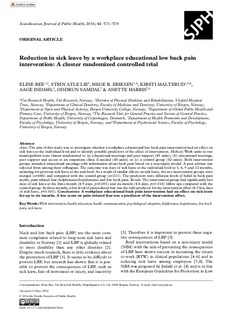| dc.contributor.author | Ree, Eline | |
| dc.contributor.author | Lie, Stein Atle | |
| dc.contributor.author | Eriksen, Hege Randi | |
| dc.contributor.author | Malterud, Kirsti | |
| dc.contributor.author | Indahl, Aage | |
| dc.contributor.author | Samdal, Oddrun | |
| dc.contributor.author | Harris, Anette | |
| dc.coverage.spatial | Norway | nb_NO |
| dc.date.accessioned | 2019-04-12T09:42:15Z | |
| dc.date.available | 2019-04-12T09:42:15Z | |
| dc.date.created | 2016-06-22T12:33:20Z | |
| dc.date.issued | 2016 | |
| dc.identifier.citation | Ree, E., Lie, S. A., Eriksen, H. R., Malterud, K., Indahl, A., Samdal, O., & Harris, A. (2016). Reduction in sick leave by a workplace educational low back pain intervention: A cluster randomized controlled trial. Scandinavian Journal of Public Health, 44(6), 571-579. | nb_NO |
| dc.identifier.issn | 1403-4948 | |
| dc.identifier.uri | http://hdl.handle.net/11250/2594457 | |
| dc.description.abstract | Aims: The aim of this study was to investigate whether a workplace educational low back pain intervention had an effect on sick leave at the individual level and to identify possible predictors of the effect of intervention. Methods: Work units in two municipalities were cluster randomized to (a) educational meetings and peer support (45 units), (b) educational meetings, peer support and access to an outpatient clinic if needed (48 units) or (c) a control group (42 units). Both intervention groups attended educational meetings with information about back pain based on a non-injury model. A peer adviser was selected from among their colleagues. The outcome was days of sick leave at the individual level at 3, 6, 9 and 12 months, adjusting for previous sick leave at the unit level. As a result of similar effects on sick leave, the two intervention groups were merged (n=646) and compared with the control group (n=211). The predictors were different levels of belief in back pain myths, pain-related fear, helplessness/hopelessness and low back pain. Results: The intervention group had significantly less days of sick leave at the three month (4.9 days, p=0.001) and six month (4.4 days, p=0.016) follow ups compared with the control group. At three months, a low level of pain-related fear was the only predictor for the intervention effect (8.0 less days of sick leave, p<0.001). Conclusions: A workplace educational back pain intervention had an effect on sick leave for up to six months. A low score on pain-related fear was a predictor of the intervention effect. | nb_NO |
| dc.language.iso | eng | nb_NO |
| dc.publisher | Sage | nb_NO |
| dc.rights | Navngivelse-Ikkekommersiell 4.0 Internasjonal | * |
| dc.rights.uri | http://creativecommons.org/licenses/by-nc/4.0/deed.no | * |
| dc.subject | work intervention | nb_NO |
| dc.subject | health education | nb_NO |
| dc.subject | health communication | nb_NO |
| dc.subject | psychological adaption | nb_NO |
| dc.subject | helplessness | nb_NO |
| dc.subject | hopelessness | nb_NO |
| dc.subject | low back pain | nb_NO |
| dc.subject | sick leave | nb_NO |
| dc.title | Reduction in sick leave by a workplace educational low back pain intervention: A cluster randomized controlled trial | nb_NO |
| dc.type | Journal article | nb_NO |
| dc.type | Peer reviewed | nb_NO |
| dc.description.version | publishedVersion | nb_NO |
| dc.rights.holder | © 2016 the Nordic Societies of Public Health | nb_NO |
| dc.source.pagenumber | 571-579 | nb_NO |
| dc.source.volume | 44 | nb_NO |
| dc.source.journal | Scandinavian Journal of Public Health | nb_NO |
| dc.source.issue | 6 | nb_NO |
| dc.identifier.doi | 10.1177/1403494816653854 | |
| dc.identifier.cristin | 1363291 | |
| cristin.unitcode | 203,1,17,0 | |
| cristin.unitname | AL-Idrettsseksjonen - Bergen | |
| cristin.ispublished | true | |
| cristin.fulltext | original | |
| cristin.qualitycode | 1 | |

